Virtual Space-Time DiversityTurbo Equalization Using Cluster Sparse Proportional Recursive Least Squares Algorithm for Underwater Acoustic Communications
Abstract
:1. Introduction
2. System Model
2.1. Cluster Sparse UWA Channel
2.2. Transmitted Signal Pattern
2.3. Discrete Received Signal Pattern
3. Virtual Space-Time Diversity Turbo Equalization
3.1. FS-SE with Anti-Doppler Module
3.2. Cluster Sparse -PRLS Adaptive Filtering Algorithm
3.3. Bidirectional Combination
3.4. Soft DA-TEQ
4. Results
4.1. Simulations
4.2. Experiments
5. Conclusions
- (1)
- For time-varying UWA channels, the Doppler effect should be finely compensated to guarantee the stability of UWA communication. We concentrated on the fine Doppler estimation and compensation because of the low Doppler estimation accuracy demand of signal synchronization. The proposed anti-Doppler module embeds an interpolator with Farrow structure into the DPLL; thus, the cumulative timing error will be eliminated in time. To couple the ADM and equalizer effectively, we introduced the integral-zeroing module to smooth the noisy phase error. The controlling parameters of the ADM are calculated according to the output of the loop filter. Owing to the adjustable interpolator in cooperation with the DPLL, the time-scale distortion caused by the dynamic Doppler effect can be alleviated. The proposed anti-Doppler module achieves available noise reduction in phase detection, and the field lake trial verifies the reliability and robustness of the proposed scheme in time-varying UWA communication situations.
- (2)
- To satisfy the cluster-sparse UWA channel, we considered a system transmission model with grouped multipaths. The excellent performance of the PRLS algorithm has been confirmed for sparse identification. To accelerate the convergence speed and accomplish a reduction in steady-state error, we exploited the hybrid norm regularization to rebuild the cost function of the adaptive algorithm. Combined with the proportional updating mechanism, the so-called -PRLS algorithm was obtained to settle the cluster-sparse problems. Experiments have shown that the resulting -PRLS algorithm presents performance superiority over existing PRLS-type algorithms in specific channels. The main drawback of the proposed adaptive algorithm is the process of parameter configuration.
- (3)
- Turbo equalization or turbo receiver is the appropriate implementation structure to reduce the troublesome ISI for single-carrier UWA communication systems. We utilized the SIC filter to solve the noncausal interference of the channel, and the SIC should only be applied after the extrinsic soft symbols of the decoder are obtained. The improved soft FS-SE is exploited to constitute the SISO equalizer in the turbo receiver structure. To eliminate the error propagation of the feedback equalizer further, the VTRM technology is employed in our proposed VSTD-TEQ scheme. We considered that the bidirectional received baseband signals are approximatively independently identically distributed, and the experiment result demonstrated that the cross-correlation coefficient of the bidirectional input reduces along with the growth of the fractionally spaced order. In particular, the cross-correlation coefficient is approximately only 0.1, while the fractionally spaced order is 1/8, which verifies the rationality of the bidirectional structure. Therefore, the proposed scheme is a suitable receiving implementation for fast time-varying UWA channels. The results of the simulations and the lake trial demonstrate that the proposed scheme achieves obvious MMSE and BER performance improvement over existing similar schemes.
Author Contributions
Funding
Institutional Review Board Statement
Informed Consent Statement
Data Availability Statement
Conflicts of Interest
Abbreviations
| PNT | positioning, navigation and timing |
| UWA | underwater acoustic |
| ROV | remotely operated vehicle |
| AUV | autonomous underwater vehicle |
| UCNDIS | UWA communication, navigation and detection integration system |
| USBL | ultra short base line |
| ISI | inter-symbol interference |
| DFE | decision-feedback equalizer |
| DPLL | digital phase locked loop |
| BER | bit error rate |
| MAP | a maximum a posteriori |
| SISO | soft-input soft-output |
| MMSE | minimum mean squared error |
| LSER | least symbol error rate |
| VTRM | virtual time reversal mirror |
| FSE | fractionally spaced equalizer |
| CE-TEQ | channel-estimation-based turbo equalization |
| DA-TEQ | direct-adaptation-based turbo equalization |
| SDA-TEQ | soft DA-TEQ |
| LMS | least mean square |
| IPNLMS | improved proportional normalized LMS |
| MIMO | multi-input multi-output |
| FOLMS | fast self-optimized LMS |
| RLS | recursive least-squares |
| PRLS | proportional RLS |
| VSTD-TEQ | virtual space-time diversity turbo equalization |
| FS-SE | fractionally spaced soft interference cancellationequalizer |
| CIR | channel impulse response |
| AWGN | additive white Gaussian noise |
| B-CG | Bernoulli-Complex Gaussian |
| PSK | phase shift keying |
| RSC | recursive system convolutional |
| ADC | analog to digital converter |
| ADM | anti-Doppler module |
| SIC | soft interference cancellation |
| FFF | feedforward filter |
| FBF | feedback filters |
| PD | phase detector |
| NCO | numberically controlled oscillator |
| LPF | lowpass filter |
| LF | loop filter |
| EP | error propagation |
| EXIT | extrinsic information transfer |
| MI | mutual information |
References
- Zhang, T.; Han, G.; Lin, C. Integration of Communication, Positioning, Navigation and Timing for Deep-Sea Vehicles. IEEE Netw. 2020, 34, 121–127. [Google Scholar] [CrossRef]
- Lv, C.; Shen, B.; Zhang, S. Study of Underwater Acoustic Positioning and Communication Integrated System Signal. In Proceedings of the 2022 7th International Conference on Intelligent Computing and Signal Processing (ICSP), Xi’an, China, 15–17 April 2022. [Google Scholar]
- İnce, T.; Çakir, S. Tightly and Loosely Coupled Architectures for Inertial Navigation System and Doppler Velocity Log Integration at Autonomous Underwater Vehicles. In Proceedings of the 2022 30th Signal Processing and Communications Applications Conference (SIU), Safranbolu, Turkey, 15–18 May 2022. [Google Scholar]
- Furfaro, T.C.; Alves, J. A communications and relative navigation architecture for underwater vehicle coordination. In Proceedings of the OCEANS 2015—MTS/IEEE Washington, Washington, DC, USA, 19–22 October 2015. [Google Scholar]
- Parastoo, Q.; Stojanovic, M. Statistical Characterization and Computationally Efficient Modeling of a Class of Underwater Acoustic Communication Channels. IEEE J. Ocean. Eng. 2013, 38, 701–717. [Google Scholar]
- Wu, W.; Gao, X.; Sun, C. Shallow Underwater Acoustic Massive MIMO Communications. IEEE Trans. Signal Process. 2021, 69, 1124–1139. [Google Scholar] [CrossRef]
- Lv, Z.; Du, L.; Li, H. Influence of Temporal and Spatial Fluctuations of the Shallow Sea Acoustic Field on Underwater Acoustic Communication. Sensors 2022, 22, 5795. [Google Scholar] [CrossRef]
- Manishika, R.; Brejesh, L.; Seshan, S. Statistical Modeling and Performance Analysis of Cooperative Communication in Frequency-Selective Underwater Acoustic Channel Using Vector Sensor. IEEE Sens. J. 2021, 21, 7367–7379. [Google Scholar]
- Li, Z.; Stojanovic, M. Multicarrier Acoustic Communications in Multiuser and Interference-Limited Regimes. IEEE J. Ocean. Eng. 2023, 48, 542–553. [Google Scholar] [CrossRef]
- Avrashi, G.; Amar, A.; Cohen, I. Time-varying carrier frequency offset estimation in OFDM underwater acoustic communication. Signal Process. 2022, 190, 108299. [Google Scholar] [CrossRef]
- Tuchler, M.; Koetter, R.; Singer, A.C. Turbo equalization: Principles and new results. IEEE Trans. Commun. 2002, 50, 754–767. [Google Scholar] [CrossRef]
- Otnes, R.; Tuchler, M. Iterative channel estimation for turbo equalization of time-varying frequency-selective channels. IEEE Trans. Wirel. Commun. 2004, 3, 1918–1923. [Google Scholar] [CrossRef]
- Yellepeddi, A.; Preisig, J.C. Adaptive equalization in a turbo loop. IEEE Trans. Wirel. Commun. 2015, 14, 5111–5122. [Google Scholar] [CrossRef]
- Zheng, T.; Jing, L.; Long, C. Frequency domain direct adaptive turbo equalization based on block normalized minimum-SER for underwater acoustic communications. Appl. Acoust. 2023, 205, 109266. [Google Scholar] [CrossRef]
- Duan, W.; Tao, J.; Zheng, Y. Efficient adaptive turbo equalization for multiple-input–multiple-output underwater acoustic communications. IEEE J. Ocean. Eng. 2017, 43, 792–804. [Google Scholar] [CrossRef]
- Xi, J.; Yan, S.; Xu, L. Soft direct-adaptation based bidirectional turbo equalization for MIMO underwater acoustic communications. China Commun. 2017, 14, 1–12. [Google Scholar] [CrossRef]
- Rudander, J.; Paul, A.; Thor, H. Very-High-Frequency Single-Input–Multiple-Output Acoustic Communication in Shallow Water. IEEE J. Ocean. Eng. 2018, 44, 943–955. [Google Scholar] [CrossRef]
- Xu, L.; Zhong, X.; Yu, H. Spatial and time-reversal diversity aided least-symbol-error-rate turbo receiver for underwater acoustic communications. IEEE Access 2018, 6, 9049–9058. [Google Scholar] [CrossRef]
- Zhang, M.; Wang, Y.; Tu, X. Recursive Least Squares-Algorithm-Based Normalized Adaptive Minimum Symbol Error Rate Equalizer. IEEE Commun. Lett. 2023, 27, 317–321. [Google Scholar] [CrossRef]
- Bozzi, F.A.; Jesus, S.M. Joint Vector Sensor Beam Steering and Passive Time Reversal for Underwater Acoustic Communications. IEEE Access 2022, 10, 66952–66960. [Google Scholar] [CrossRef]
- Siddiqui, S.I.; Dong, H. Time Diversity Passive Time Reversal for Underwater Acoustic Communications. IEEE Access 2019, 7, 24258–24266. [Google Scholar] [CrossRef]
- Ghassem, N.; Philippa, A.M.; Desmond, P.T. Spectral analysis of fractionally-spaced MMSE equalizers and stability of the LMS algorithm. IEEE Trans. Commun. 2017, 66, 1675–1688. [Google Scholar]
- Xi, J.; Yan, S.; Xun, L. Sparsity-Aware Adaptive Turbo Equalization for Underwater Acoustic Communications in the Mariana Trench. IEEE J. Ocean. Eng. 2021, 46, 338–351. [Google Scholar] [CrossRef]
- Liang, Y.; Yu, H.; Ji, F. Multitask Sparse Bayesian Channel Estimation for Turbo Equalization in Underwater Acoustic Communications. IEEE J. Ocean. Eng. 2023, 48, 946–962. [Google Scholar] [CrossRef]
- Qin, X.; Qu, F.; Zheng, Y. Bayesian Iterative Channel Estimation and Turbo Equalization for Multiple-Input-Multiple-Output Underwater Acoustic Communications. IEEE J. Ocean. Eng. 2021, 46, 326–337. [Google Scholar] [CrossRef]
- Qin, X.; Diamant, R. Joint Channel Estimation and Decoding for Underwater Acoustic Communication with a Short Pilot Sequence. IEEE J. Ocean. Eng. 2023, 48, 526–541. [Google Scholar]
- Meng, Q.; Huang, J.; Han, J. An improved direct adaptive multichannel turbo equalization scheme for underwater communications. In Proceedings of the Oceans 2012—Yeosu, Yeosu, Republic of Korea, 21–24 May 2012. [Google Scholar]
- Qin, Z.; Tao, J.; Han, X. Sparse direct adaptive equalization based on proportionate recursive least squares algorithm for multiple-input multiple-output underwater acoustic communications. J. Acoust. Soc. Am. 2020, 148, 2280–2287. [Google Scholar] [CrossRef]
- Liu, L.; Zhang, Y.; Sun, D. VFF l_1-norm penalised WL-RLS algorithm using DCD iterations for underwater acoustic communication. IET Commun. 2017, 11, 615–621. [Google Scholar] [CrossRef]
- Tao, J.; Wu, Y.; Han, X. Sparse direct adaptive equalization for single-carrier MIMO underwater acoustic communications. IEEE J. Ocean. Eng. 2019, 45, 1622–1631. [Google Scholar] [CrossRef]
- Zhang, Y.; Zakharov, Y.; Li, J. Soft-decision-driven sparse channel estimation and turbo equalization for MIMO underwater acoustic communications. IEEE Access 2018, 6, 4955–4973. [Google Scholar] [CrossRef]
- Qin, Z.; Tao, J.; Xia, Y.; Le, Y. Proportionate RLS with l1 norm regularization: Performance analysis and fast implementation. Digit. Signal Process. 2022, 122, 103366. [Google Scholar] [CrossRef]
- Qin, Z.; Tao, J.; Tong, F.; Zhang, H. A fast proportionate RLS adaptive equalization for underwater acoustic communications. In Proceedings of the OCEANS 2019—Marseille, Marseille, France, 17–20 June 2019. [Google Scholar]
- Liu, Z.; Bai, F.; Song, L. Underwater decode-interleave-forward cooperative strategy for underwater acoustic communication. IEEE Access 2019, 7, 19698–19708. [Google Scholar] [CrossRef]
- Yan, L.; Ma, X.; Li, X. Shot Interference Detection and Mitigation for Underwater Acoustic Communication Systems. IEEE Trans. Commun. 2021, 69, 3274–3285. [Google Scholar] [CrossRef]
- Roy, S.; Duman, T.; McDonald, V. High-rate communication for underwater acoustic channels using multiple transmitters and space–time coding: Receiver structures and experimental results. IEEE J. Ocean. Eng. 2007, 32, 663–688. [Google Scholar] [CrossRef]
- Wang, S.; Liu, M.; Li, D. Bayesian learning-based clustered-sparse channel estimation for time-varying underwater acoustic OFDM communication. Sensors 2021, 21, 4889. [Google Scholar] [CrossRef] [PubMed]
- Sun, D.; Hong, X.; Cui, H.; Liu, L. A Symbol-Based Passband Doppler Tracking and Compensation Algorithm for Underwater Acoustic DSSS Communications. J. Commun. Inf. Netw. 2020, 5, 168–176. [Google Scholar] [CrossRef]
- Shen, L.; Benjamin, H.; Zakharov, Y.; Mitchell, P. Digital Self-Interference Cancellation for Full-Duplex Underwater Acoustic Systems. IEEE Trans. Circuits Syst. 2020, 67, 192–196. [Google Scholar] [CrossRef]
- Jiang, P.; Shi, C.; Wu, M. Simulations of code and carrier loop by Farrow interpolation in BD Navigation System. Geomat. Inf. Sci. Wuhan Univ. 2009, 34, 548–551. [Google Scholar]
- Qiao, G.; Zhao, Y.; Liu, S. Doppler scale estimation for varied speed mobile frequency-hopped binary frequency-shift keying underwater acoustic communication. J. Acoust. Soc. Am. 2019, 146, 998–1004. [Google Scholar] [CrossRef]
- Pelekanakis, K.; Chitre, M. Robust equalization of mobile underwater acoustic channels. IEEE J. Ocean. Eng. 2015, 40, 775–784. [Google Scholar] [CrossRef]
- Riedl, T.; Singer, A. MUST-READ: Multichannel sample-by-sample turbo resampling equalization and decoding. In Proceedings of the 2013 MTS/IEEE OCEANS—Bergen, Bergen, Norway, 10–14 June 2013. [Google Scholar]
- Li, Y.; Jiang, Z.; Jin, Z.; Han, X.; Yin, J. Cluster-Sparse Proportionate NLMS Algorithm with the Hybrid Norm Constraint. IEEE Access 2018, 6, 47794–47803. [Google Scholar] [CrossRef]
- Pelekanakis, K.; Blouin, S.; Green, D. Performance Analysis of Underwater Acoustic Communications in Barrow Strait. IEEE J. Ocean. Eng. 2021, 46, 1438–1449. [Google Scholar] [CrossRef]
- Liu, Y.; Chen, Y.; Meng, Z. Performance of single empirical orthogonal function regression method in global sound speed profile inversion and sound field prediction. Appl. Ocean Res. 2023, 136, 103598. [Google Scholar]
- Yan, Z.; Yang, X.; Sun, L. Inter-carrier interference-aware sparse time-varying underwater acoustic channel estimation based on fast reconstruction algorithm. China Commun. 2021, 18, 216–225. [Google Scholar] [CrossRef]

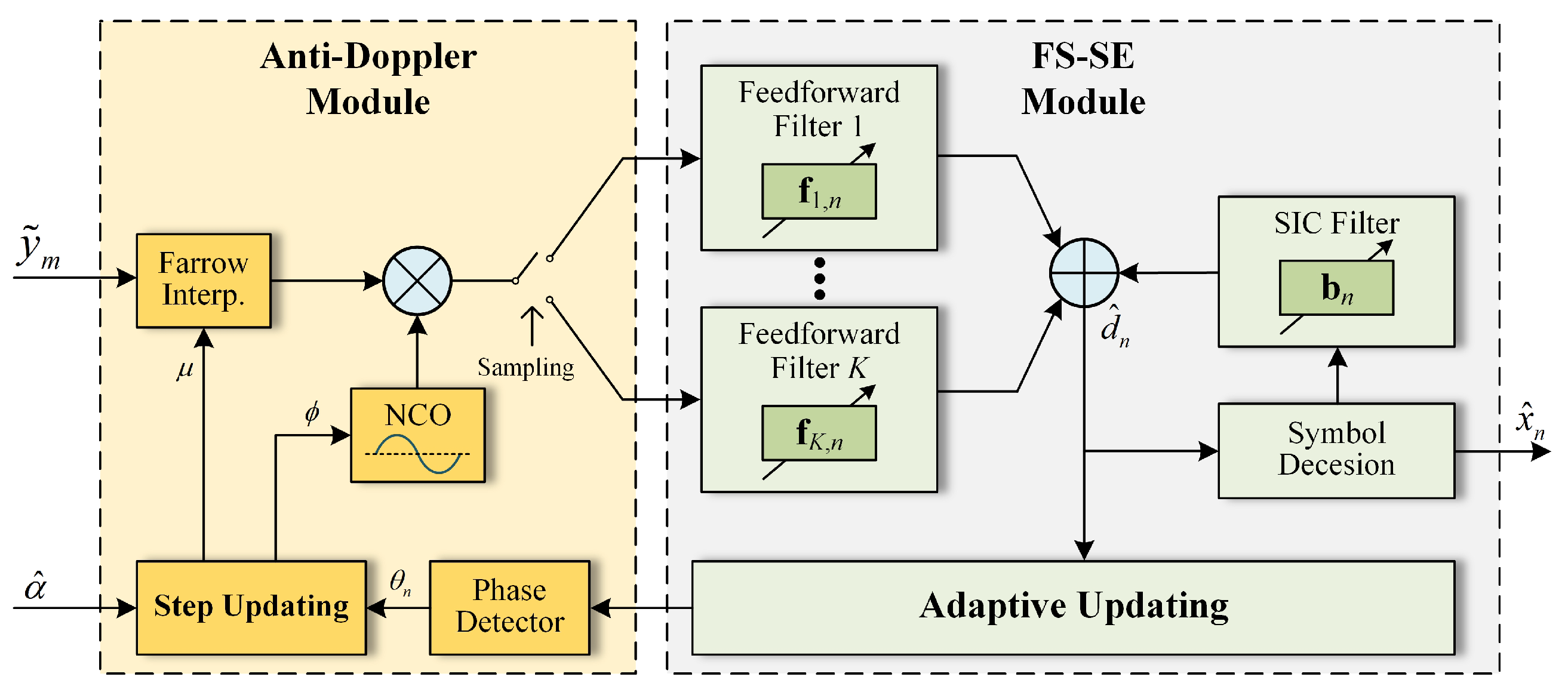

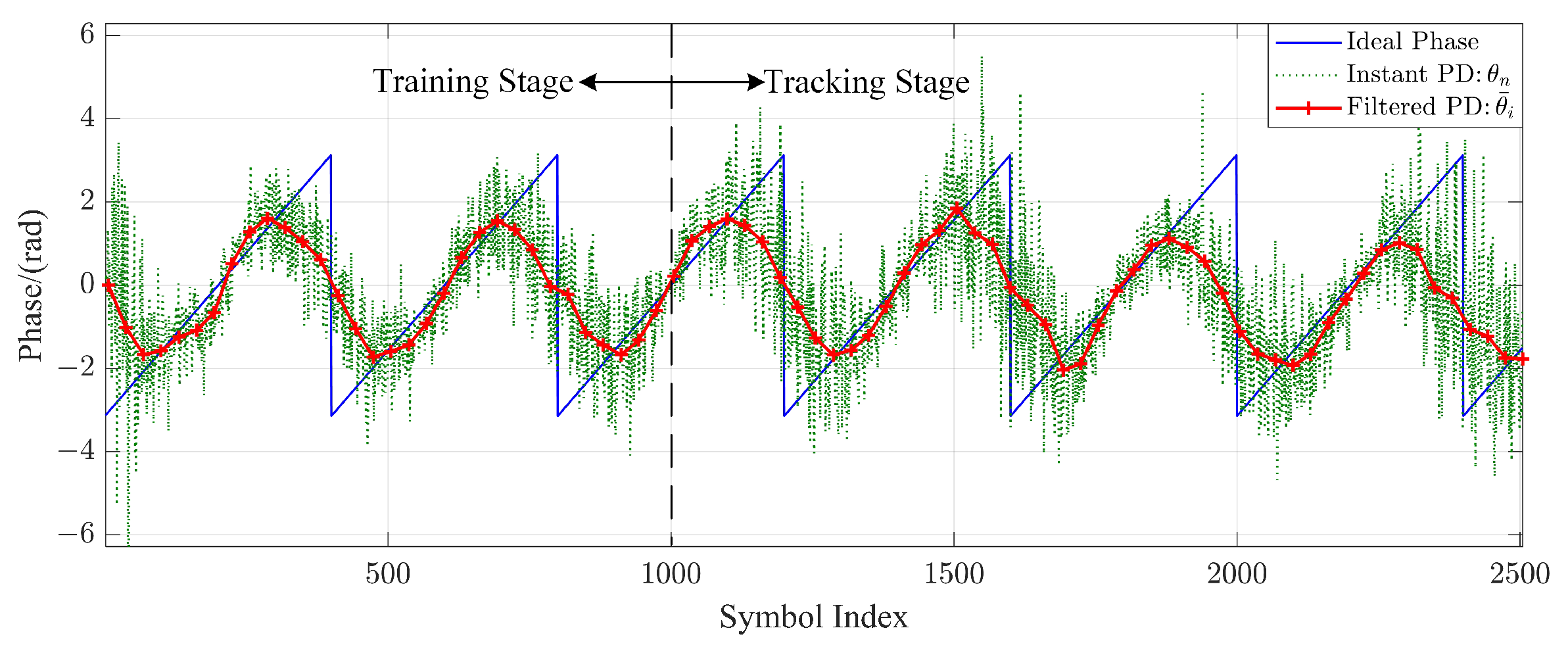
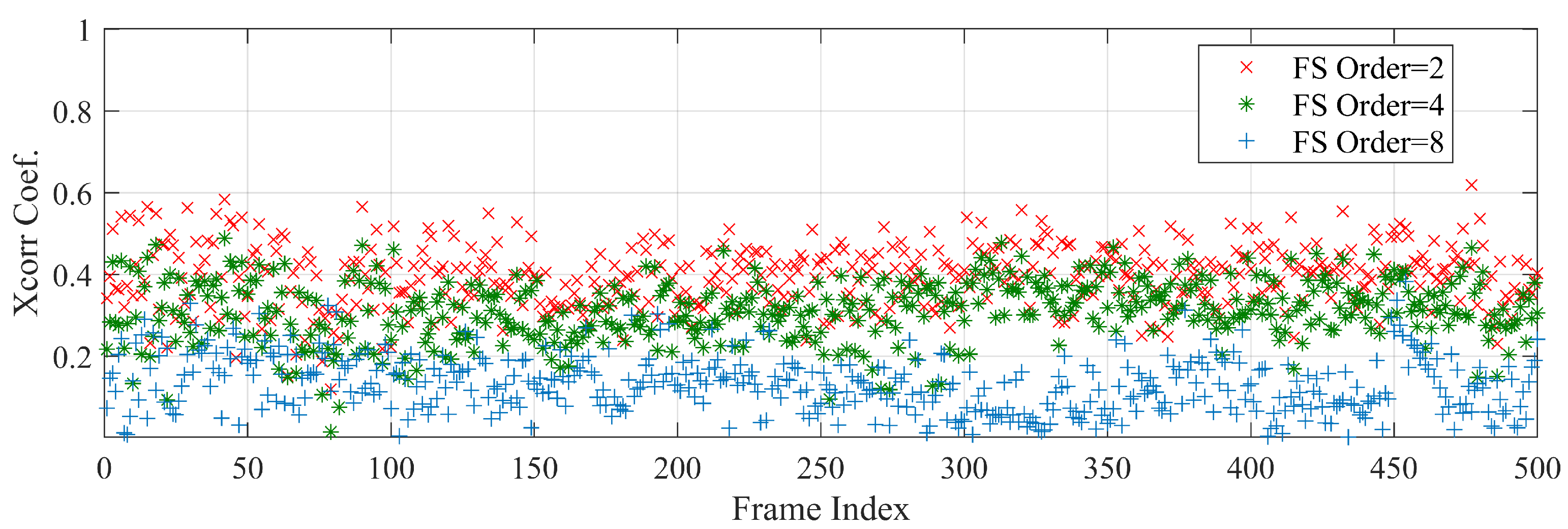

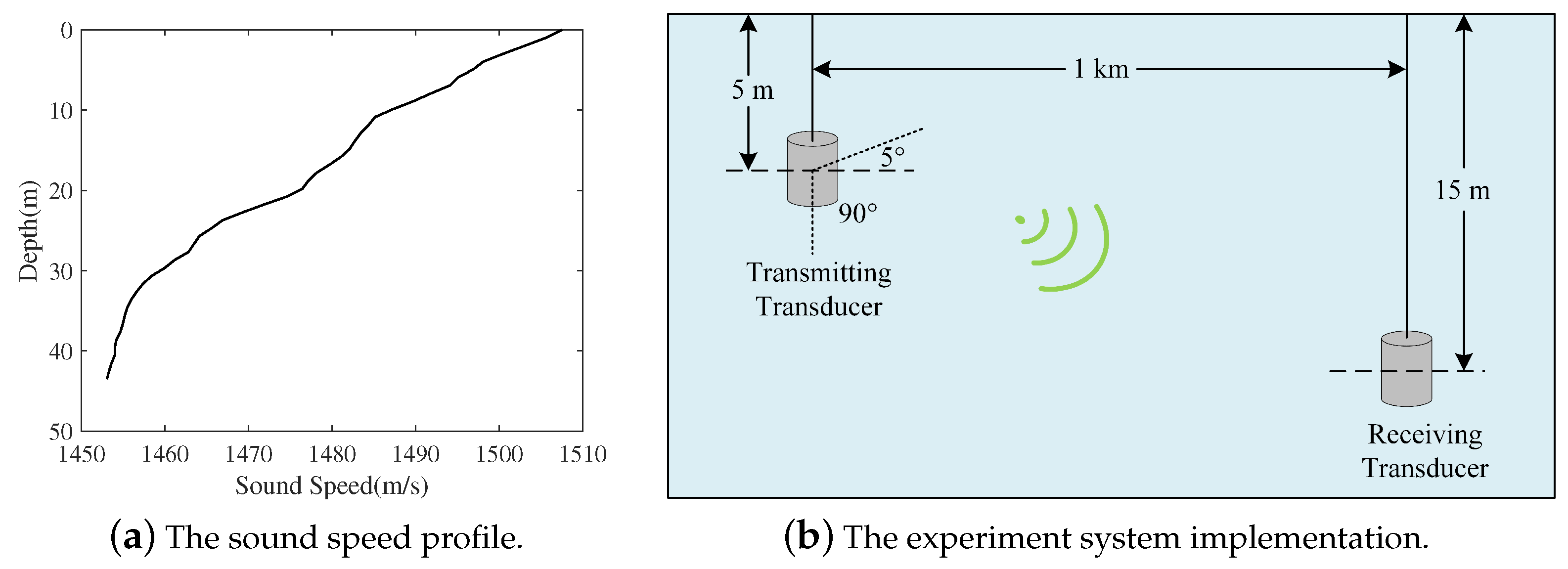
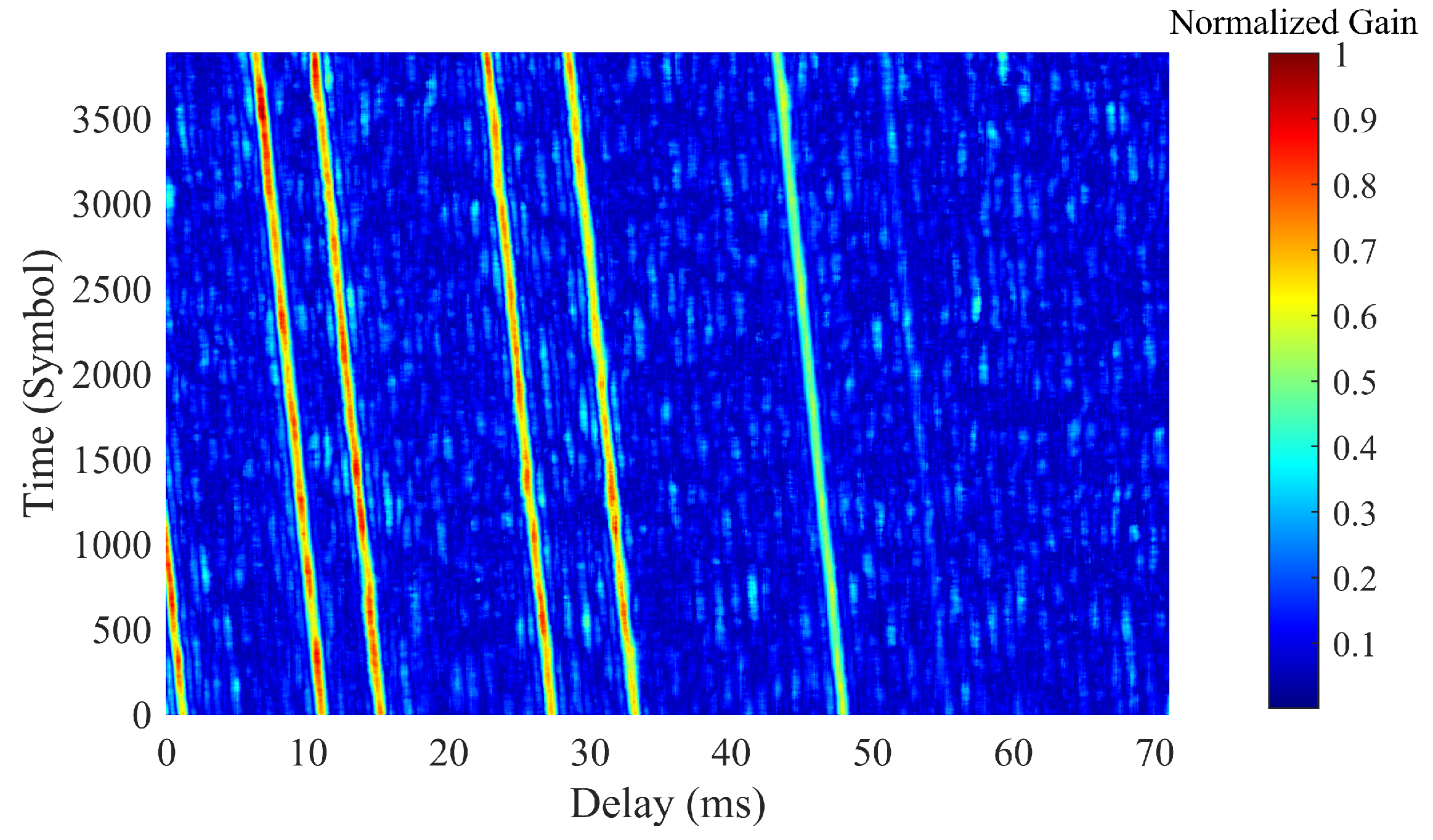
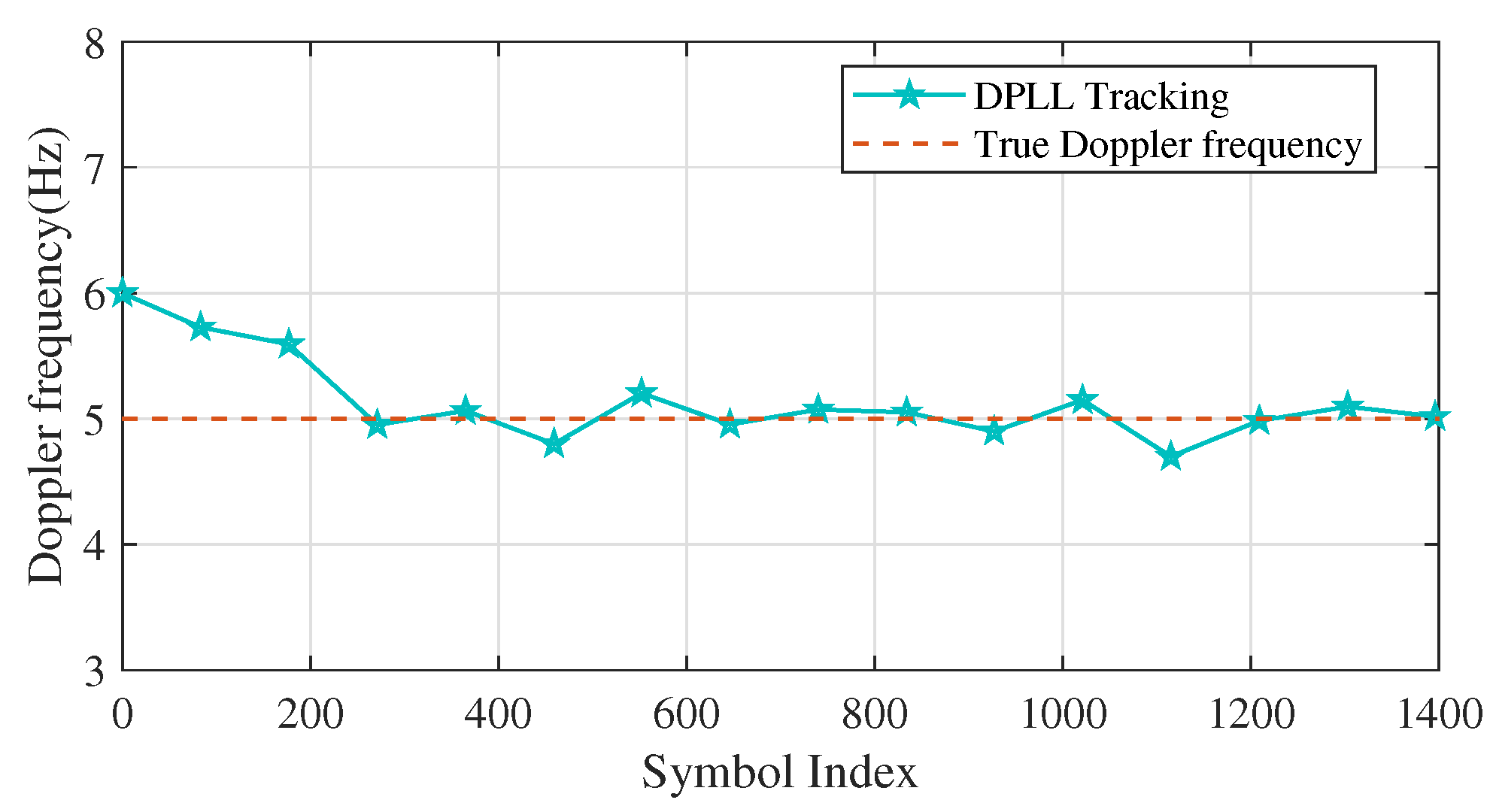
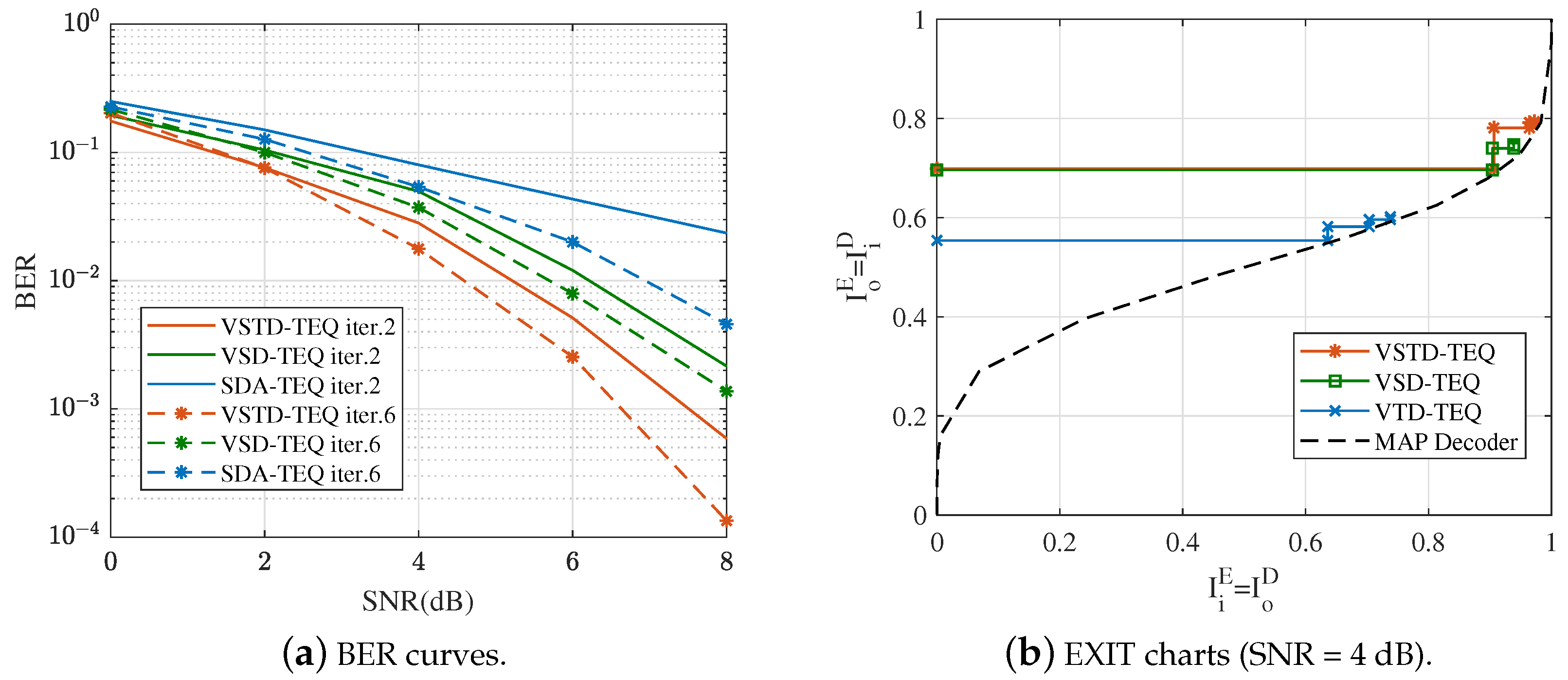
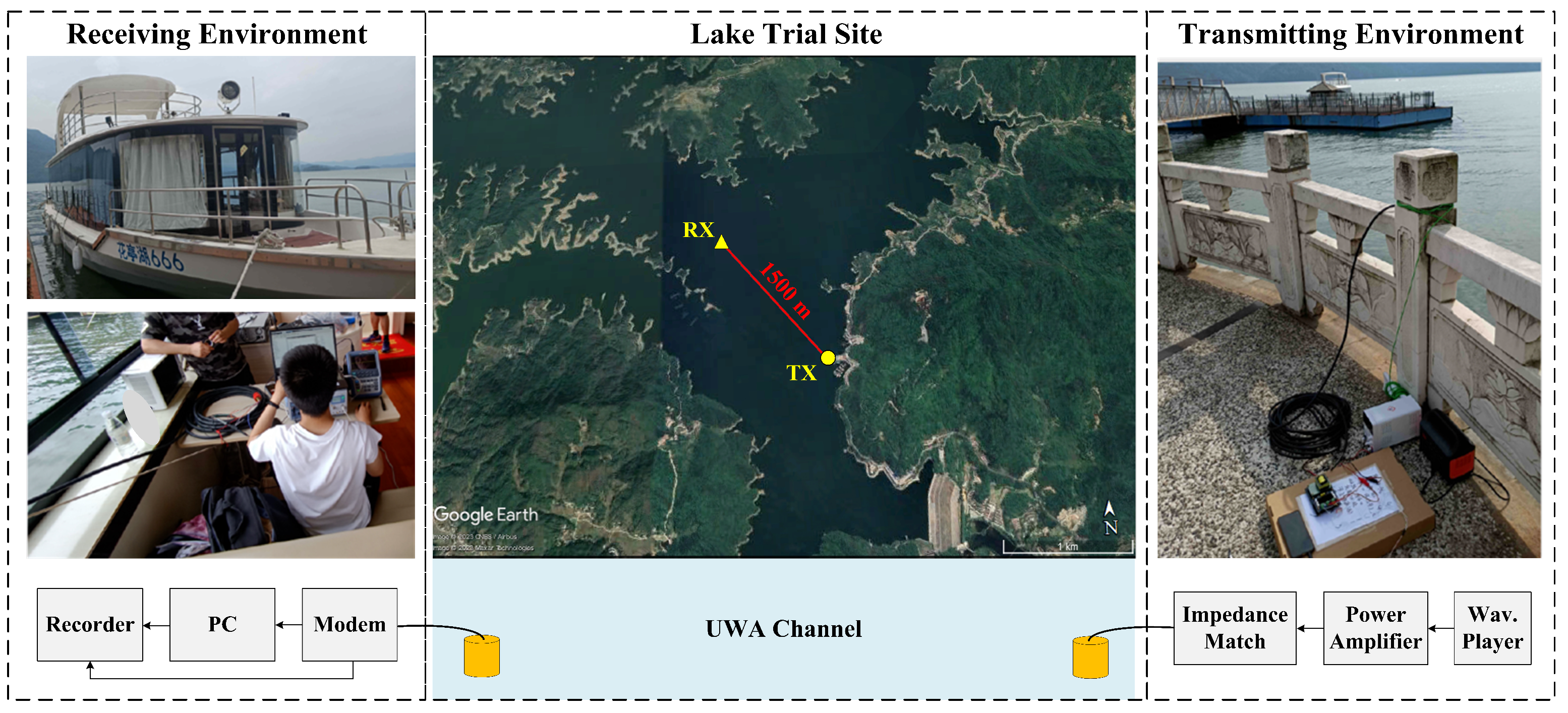



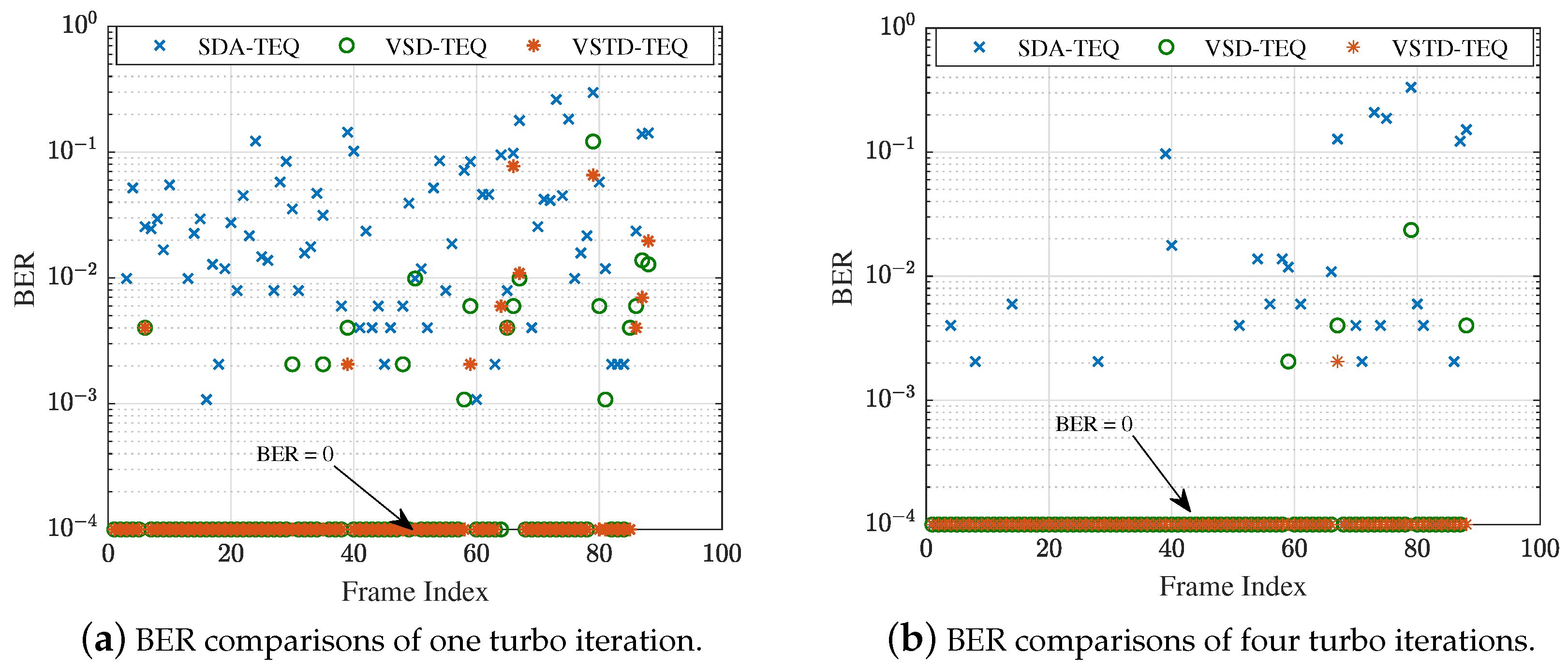
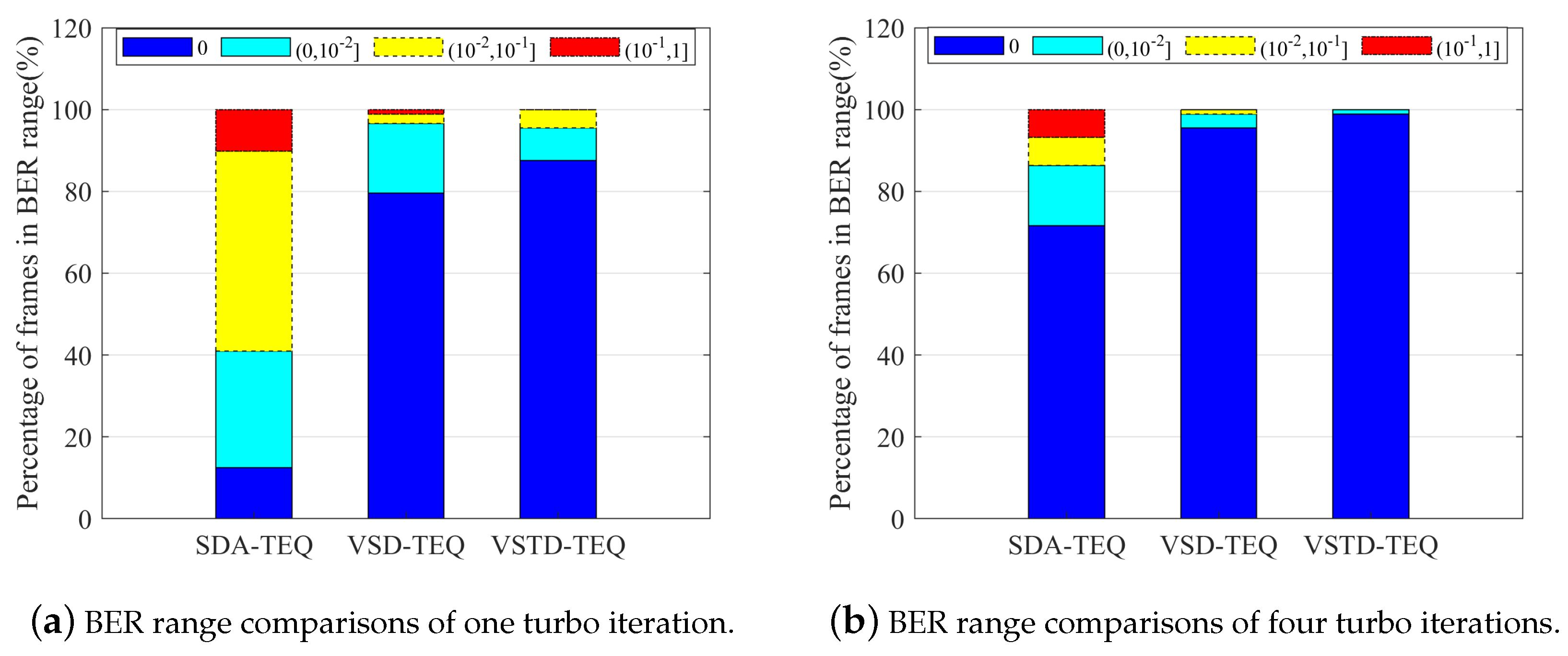

| 1 1 | 3 |
| 0 2 | |
| 4 | |
Disclaimer/Publisher’s Note: The statements, opinions and data contained in all publications are solely those of the individual author(s) and contributor(s) and not of MDPI and/or the editor(s). MDPI and/or the editor(s) disclaim responsibility for any injury to people or property resulting from any ideas, methods, instructions or products referred to in the content. |
© 2023 by the authors. Licensee MDPI, Basel, Switzerland. This article is an open access article distributed under the terms and conditions of the Creative Commons Attribution (CC BY) license (https://creativecommons.org/licenses/by/4.0/).
Share and Cite
Han, Z.; Tao, W.; Zhang, D.; Jiang, P. Virtual Space-Time DiversityTurbo Equalization Using Cluster Sparse Proportional Recursive Least Squares Algorithm for Underwater Acoustic Communications. Appl. Sci. 2023, 13, 11050. https://doi.org/10.3390/app131911050
Han Z, Tao W, Zhang D, Jiang P. Virtual Space-Time DiversityTurbo Equalization Using Cluster Sparse Proportional Recursive Least Squares Algorithm for Underwater Acoustic Communications. Applied Sciences. 2023; 13(19):11050. https://doi.org/10.3390/app131911050
Chicago/Turabian StyleHan, Zhen, Weiliang Tao, Dan Zhang, and Peng Jiang. 2023. "Virtual Space-Time DiversityTurbo Equalization Using Cluster Sparse Proportional Recursive Least Squares Algorithm for Underwater Acoustic Communications" Applied Sciences 13, no. 19: 11050. https://doi.org/10.3390/app131911050
APA StyleHan, Z., Tao, W., Zhang, D., & Jiang, P. (2023). Virtual Space-Time DiversityTurbo Equalization Using Cluster Sparse Proportional Recursive Least Squares Algorithm for Underwater Acoustic Communications. Applied Sciences, 13(19), 11050. https://doi.org/10.3390/app131911050






